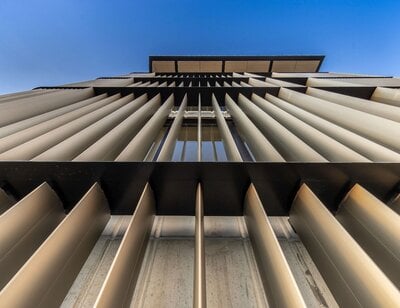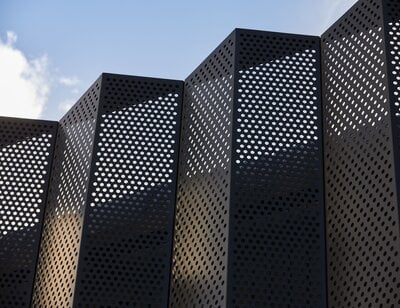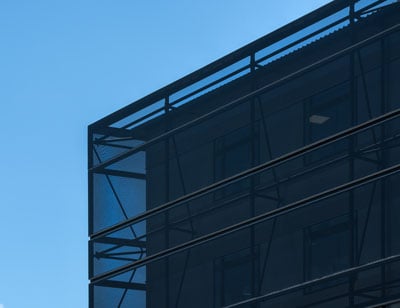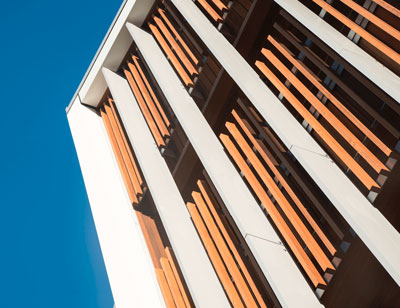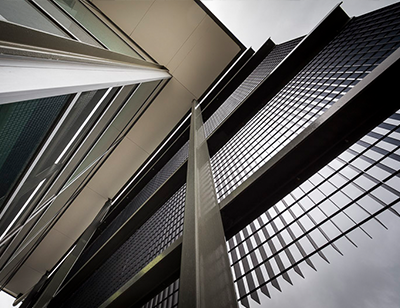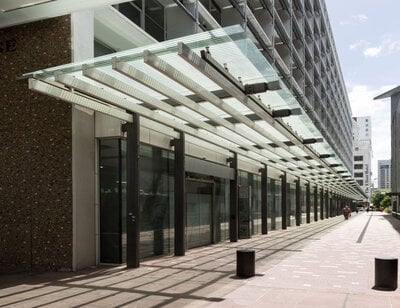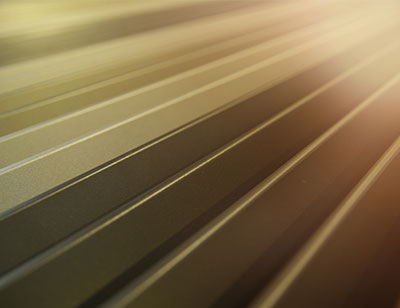Trying to understand and describe the ‘Moire Effect’ and how it occurs (and might occur) has tested the ability of great minds like that of the Nobel Prize-winning physicist John William Strutt, better known as Lord Raleigh. It has also tested the sanity of minds like that of Gerald Oster, sometimes under medically administered LSD, as was the case when he penned ‘Moire Patterns and Visual Hallucinations’ for ‘The Psychedelic Review’.
History of the Moire Effect
It’s Lord Raleigh who is generally credited with ‘discovering’ the Moire effect when he suggested using it for grating analysis (the study and calculation of how light interacts with a periodic structure called a gratin). Raleigh wasn’t interested in architectural effect as much as he was studying optics and should anyone ask you ‘why is the sky blue?’, then you can thank Lord Raleigh for the answer, which is essentially ‘λ-4’, or in accessible terms; if the light in the sky is scattered from particles much smaller than the wavelength of the incident light, blue light should be scattered 16x more than red light, which is why the sky is blue.
However, while the above might be the first known example of blue sky thinking (we’re joking), the origins of the moire effect can be traced back much earlier. Earlier even than the words used to describe it.
Leon Battista Alberti published his treatise ‘De Pictoria’ (On Painting) in 1434. A student of mathematics as much as art, he studied classical optics and wrote about perspective, describing how wave lines can be used in producing art. His words might not directly attribute the effects he was describing as moire, but that’s because the term wasn’t invented yet.
Indeed, it wouldn’t be until the 1650s that the French word moire came into circulation. It essentially means ‘watered silk’. This particular fabric used two layers pressed together, creating a rippled appearance as the threads from the fabric, while similar, were not perfectly aligned. It’s from this that we derive the term ‘moire effect’, used to describe the optical illusion created when two patterns with similar but misaligned structures are overlaid, resulting in a fringe pattern.
Despite the aesthetic significance of the moire effect, it would primarily be thought of in scientific terms and the grating analysis association first proposed by Lord Raleigh, would continue with the work of Ronchi, Raman and Datta in the 1920s, followed by C Guild, with his groundbreaking book ‘The Physics of Moire Metrology’ in 1958.
Why are so many scientists focused on the moire effect? Maybe it’s because we’re still discovering how the physical manifestation of the moire effect (i.e., the composite layers used) can lead to surprising benefits. For example, following Andre Grim and Konstantin Noselov’s graphene discovery (a material made from a single layer of carbon atoms in a lattice), it was found that by stacking two layers of graphene, with one turned slightly (i.e., misaligned), the resulting material becomes a superconductor and is extraordinarily strong. So why we might look at the pretty patterns, behind them, something very special is happening.
The Moire Effect in Architecture
Just when the moire effect was first used in architecture might never be known. There’s every chance it occurred accidentally, rather than on purpose though. Whenever a design uses layering or repeating elements, there’s the risk of an accidental moire effect. It would be unreasonable to suppose such a result would occur on purpose before accidentally, given the use of patterns from the very earliest times of design.
What we do know is that there are a number of architectural applications where the moire effect can show up, either by design or by accident:
Perforated metal panels. When configured to overlap or spaced closely as part of a double skin facade, perforated panels will often create a moire effect.
Louvres. When sequenced either vertically or horizontally, louvres viewed from a shifting perspective (such as walking past) can trigger a moire effect.
Expanded Mesh. Similar to the above, and especially when seen under artificial lighting, a moire effect can reveal itself.
Depending on the obviousness of the moire effect, any accidental occurrence featured in the above applications might not be cause for concern. However, if it interferes with the architectural intent by breaking the harmony of the design with unexpected lines, it is. As are cases where a moire effect might give the perception of a defect, or worse, when it causes discomfort and disorientation in individuals with certain neurological conditions.
Avoiding An Unwanted Moire Effect
Preventing issues with an unwanted moire effect is possible. Different pattern sizes and orientations can ensure that any near-alignment never occurs, reducing the risk of accidental moire. As can increasing the physical distance between layers of patterns. And of course, if patterns are randomised rather than repeated, then there is a reduced risk (or no risk).
However, these solutions often involve changing the overall design significantly and can dilute the architectural intent to a point where it may disappear entirely. For this reason, the production of a visual mock-up (VMU) or a performance mock-up (PMU) is advisable. This is especially true if the building uses interior blinds or sunshading, as we’ve seen facades combine with blinds to create an unintended moire effect before.
Intentional use of the Moire Effect
The above shouldn’t lead to the conclusion that the moire effect is to be avoided. Indeed, when created intentionally, the effect can be mesmerising, with an almost magical quality to it. As a design tool, it has significant potential and, when harnessed correctly, will create a facade that seemingly moves, with a life of its own.
Take, for example, a dynamic facade made from two layers of screens. For the observer walking past or looking up, the facade becomes animated. It not only captures attention but transfixes it. The effect might be enhanced by lighting to manipulate the shadowplay, adding further depth and visual intrigue to the facade.
A kinetic facade might take this a level further. With moveable or interactive facade elements, a moire effect can be revealed intentionally to engage the viewer. This could be in response to environmental stimulus or perhaps even what’s happening inside the building (like a stadium facade with shifting patterns when a sport is being played inside).
The good news is that creating a specific moire pattern is simply a case of applying the right mathematical equation. For example, if you wanted to create straight moire fringes with expanded mesh, then we know it’s a case of applying the following formula:
y + n (x, y) + f (x, y) = np,
y + n (x, y) = mp
Ok, so it might not be simple then. But the point is, there is precedent for particular patterns, and producing types of effects is very doable, as can be seen in the examples to follow.
Example of Moire Effect in Architecture
Ned Kahn’s Moire Bridge at Union Station in Los Angeles uses two layers of perforated panels, with the outer panels hinged and able to move in the wind. The result is a moire effect, which gives the bridge movement as it ripples and waves. It’s fascinating to see the panels seemingly bend and distort as if made from a futuristic metallic silk.
Another striking example is the Optic Cloak by British Architect Conrad Shawcross. His 49 metre high installation in London distorts views of the chimneys encased within, using folded aluminum perforated panels to create a moire effect. The panels are angled to capture the moving sun, and at different times of the day, the installation will appear either solid or transparent. At all times, the design is certainly beguiling and worthy of conversation.
Then there’s the Brisbane Girls Grammar School by M3 Architecture. Facing the playing fields, the western facade features a sunscreen set in front of a wall painted in black and white stripes. The two combine when viewed from the playing field, producing an interference pattern with curvilinear geometries.
Our final example is notable for many reasons, one of which is how it used the moire effect to add character and presence as part of a retrofit to an existing structure, showing how optical interference can breathe new life into old spaces. Fellenoord 15 by UnStudio uses a double layer of expanded mesh to add a moire effect, which reveals itself as you get closer, articulating the remodelled facade and adding a dynamism to the overall aesthetics.
Despite these examples, the moire effect is still underused in architecture, considering how visually engaging it can be. It is easy to understand why, as there is a sense of the unknown. However, with experimentation and using work that has gone before, the moire effect can be spectacular, and its rarity is precisely why its use appeals. We’ve carried out multiple experiments and will continue to do so, with the aim of furthering our own understanding of the moire effect and developing purposeful patterns. More specifically, we’ve been dabbling with our dapple patterns, placing one in front of the other and seeing what moire effects are revealed. This ‘double dapple’ is producing spectacular results and we’ll be revealing more in due course.
In the meantime, if the moire effect interests you and you’d like to learn more, then please do reach out.

